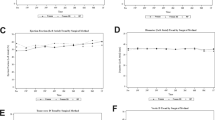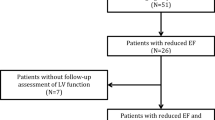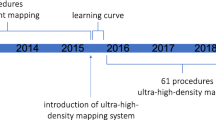Abstract
Outflow tract obstruction affects 5-10% of hypertrophic cardiomyopathy patients. Although myectomy is the gold standard treatment, alcohol septal ablation has emerged as an alternative nonsurgical procedure. Burri and Sigwart present a round up of the past 10 years' experience and discuss the pros and cons of this procedure.
This is a preview of subscription content, access via your institution
Access options
Subscribe to this journal
Receive 12 print issues and online access
$209.00 per year
only $17.42 per issue
Buy this article
- Purchase on Springer Link
- Instant access to full article PDF
Prices may be subject to local taxes which are calculated during checkout



Similar content being viewed by others
References
Maron BJ et al. (2000) Epidemiology of Hypertrophic Cardiomyopathy-Related Death: Revisited in a Large Non-Referral-Based Patient Population. Circulation 102: 858–864
Maron MS et al. (2003) Effect of Left Ventricular Outflow Tract Obstruction on Clinical Outcome in Hypertrophic Cardiomyopathy. N Engl J Med 348: 295–303
Maron BJ et al. (1987) Hypertrophic cardiomyopathy. Interrelations of clinical manifestations, pathophysiology, and therapy (1). N Engl J Med 316: 780–789
Maron BJ (2002) Hypertrophic cardiomyopathy: a systematic review. JAMA 287: 1308–1320.
Sigwart U (1995) Non-surgical myocardial reduction for hypertrophic obstructive cardiomyopathy. Lancet 346: 211–214
Brugada P et al. (1989) Transcoronary chemical ablation of ventricular tachycardia. Circulation 79: 475–482
Kuhn H et al. (1997) Induction of subaortic septal ischaemia to reduce obstruction in hypertrophic obstructive cardiomyopathy. Studies to develop a new catheter-based concept of treatment. Eur Heart J 18: 846–851
Spencer WH III and Roberts R (2000) Alcohol Septal Ablation in Hypertrophic Obstructive Cardiomyopathy: The Need for a Registry. Circulation 102: 600–601
Gietzen FH et al. (2002) Role of transcoronary ablation of septal hypertrophy in patients with hypertrophic cardiomyopathy, New York Heart Association functional class III or IV, and outflow obstruction only under provocable conditions. Circulation 106: 454–459
Kuhn H et al. (1999) Changes in the left ventricular outflow tract after transcoronary ablation of septal hypertrophy (TASH) for hypertrophic obstructive cardiomyopathy as assessed by transoesophageal echocardiography and by measuring myocardial glucose utilization and perfusion. Eur Heart J 20: 1808–1817
Lakkis NM et al. (1998) Echocardiography-guided ethanol septal reduction for hypertrophic obstructive cardiomyopathy. Circulation 98: 1750–1755
Nagueh SF et al. (1998) Role of myocardial contrast echocardiography during nonsurgical septal reduction therapy for hypertrophic obstructive cardiomyopathy. J Am Coll Cardiol 32: 225–229
Runquist LH et al. (2002) Electrocardiographic findings after alcohol septal ablation therapy for obstructive hypertrophic cardiomyopathy. Am J Cardiol 90: 1020–1022
Flores-Ramirez R et al. (2001) Echocardiographic insights into the mechanisms of relief of left ventricular outflow tract obstruction after nonsurgical septal reduction therapy in patients with hypertrophic obstructive cardiomyopathy. J Am Coll Cardiol 37: 208–214
Henein MY et al. (1999) Electromechanical left ventricular behavior after nonsurgical septal reduction in patients with hypertrophic obstructive cardiomyopathy. J Am Coll Cardiol 34: 1117–1122
Park T-H et al. (2002) Acute Effect of Nonsurgical Septal Reduction Therapy on Regional Left Ventricular Asynchrony in Patients With Hypertrophic Obstructive Cardiomyopathy. Circulation 106: 412–415
Nagueh SF et al. (1999) Changes in Left Ventricular Diastolic Function 6 Months After Nonsurgical Septal Reduction Therapy for Hypertrophic Obstructive Cardiomyopathy. Circulation 99: 344–347
Nagueh SF et al. (1999) Changes in left ventricular filling and left atrial function six months after nonsurgical septal reduction therapy for hypertrophic obstructive cardiomyopathy. J Am Coll Cardiol 34: 1123–1128
Sitges M et al. (2003) Comparison of left ventricular diastolic function in obstructive hypertrophic cardiomyopathy in patients undergoing percutaneous septal alcohol ablation versus surgical myotomy/myectomy. Am J Cardiol 91: 817–821
Boekstegers P et al. (2001) Pressure-guided nonsurgical myocardial reduction induced by small septal infarctions in hypertrophic obstructive cardiomyopathy. J Am Coll Cardiol 38: 846–853
Nagueh SF et al. (2001) Decreased expression of tumor necrosis factor-alpha and regression of hypertrophy after nonsurgical septal reduction therapy for patients with hypertrophic obstructive cardiomyopathy. Circulation 103: 1844–1850
Mazur W et al. (2001) Regression of left ventricular hypertrophy after nonsurgical septal reduction therapy for hypertrophic obstructive cardiomyopathy. Circulation 103: 1492–1496
Lakkis NM et al. (2000) Nonsurgical septal reduction therapy for hypertrophic obstructive cardiomyopathy: one-year follow-up. J Am Coll Cardiol 36: 852–855
Faber L et al. (1998) Percutaneous transluminal septal myocardial ablation in hypertrophic obstructive cardiomyopathy: results with respect to intraprocedural myocardial contrast echocardiography. Circulation 98: 2415–2421
Faber L et al. (1999) Intraprocedural myocardial contrast echocardiography as a routine procedure in percutaneous transluminal septal myocardial ablation: detection of threatening myocardial necrosis distant from the septal target area. Catheter Cardiovasc Interv 47: 462–466
Okayama H et al. (2001) Usefulness of selective myocardial contrast echocardiography in percutaneous transluminal septal myocardial ablation: a case report. Jpn Circ J 65: 842–844
Faber L et al. (2000) Targeting percutaneous transluminal septal ablation for hypertrophic obstructive cardiomyopathy by intraprocedural echocardiographic monitoring. J Am Soc Echocardiogr 13: 1074–1079
Harada T et al. (2002) Papillary muscles identified by myocardial contrast echocardiography in preparation for percutaneous transluminal septal myocardial ablation. Acta Cardiol 57: 25–27
Faber L et al. (2000) Percutaneous transluminal septal myocardial ablation for hypertrophic obstructive cardiomyopathy: long term follow up of the first series of 25 patients. Heart 83: 326–331
Seggewiss H et al. (2000) Improvement of acute results after percutaneous transluminal septal myocardial ablation in hypertrophic obstructive cardiomyopathy during mid-term follow-up [abstract]. J Am Coll Cardiol 35: 188A
Firoozi S et al. (2002) Septal myotomy-myectomy and transcoronary septal alcohol ablation in hypertrophic obstructive cardiomyopathy. A comparison of clinical, haemodynamic and exercise outcomes. Eur Heart J 23: 1617–1624
Nagueh SF et al. (2001) Comparison of ethanol septal reduction therapy with surgical myectomy for the treatment of hypertrophic obstructive cardiomyopathy. J Am Coll Cardiol 38: 1701–1706
Qin JX et al. (2001) Outcome of patients with hypertrophic obstructive cardiomyopathy after percutaneous transluminal septal myocardial ablation and septal myectomy surgery. J Am Coll Cardiol 38: 1994–2000
Gietzen FH et al. (1999) Acute and long-term results after transcoronary ablation of septal hypertrophy (TASH). Catheter interventional treatment for hypertrophic obstructive cardiomyopathy. Eur Heart J 20: 1342–1354
Seggewiss H et al. (2000) Age related acute results of percutaneous septal ablation in hypertrophic obstructive cardiomyopathy [abstract]. J Am Coll Cardiol 35: 188A
Oomman A et al. (2001) Percutaneous transluminal septal myocardial ablation in drug-resistant hypertrophic obstructive cardiomyopathy: 18-month follow-up results. J Invasive Cardiol 13: 526–530
Welge D et al. (2002) Long-term outcome after percutaneous septal ablation for hypertrophic obstructive cardiomyopathy [abstract]. J Am Coll Cardiol 39: 173A
Kim JJ et al. (1999) Improvement in exercise capacity and exercise blood pressure response after transcoronary alcohol ablation therapy of septal hypertrophy in hypertrophic cardiomyopathy. Am J Cardiol 83: 1220–1223
Knight C et al. (1997) Nonsurgical Septal Reduction for Hypertrophic Obstructive Cardiomyopathy : Outcome in the First Series of Patients. Circulation 95: 2075–2081
Kuhn H et al. (2004) Catheter-based therapy for hypertrophic obstructive cardiomyopathy. First in-hospital outcome analysis of the German TASH Registry. Z Kardiol 93: 23–31
Dimitrow PP et al. (2001) The risk of alcohol leakage into the left anterior descending coronary artery during non-surgical myocardial reduction in patients with obstructive hypertrophic cardiomyopathy. Eur Heart J 22: 437–438
Kern MJ et al. (2002) Delayed occurrence of complete heart block without warning after alcohol septal ablation for hypertrophic obstructive cardiomyopathy. Catheter Cardiovasc Interv 56: 503–507
Chang SM et al. (2003) Complete heart block: determinants and clinical impact in patients with hypertrophic obstructive cardiomyopathy undergoing nonsurgical septal reduction therapy. J Am Coll Cardiol 42: 296–300
ten Berg JM et al. (1994) Hypertrophic obstructive cardiomyopathy. Initial results and long-term follow-up after Morrow septal myectomy. Circulation 90: 1781–1785
Kazmierczak J et al. (1998) Electrocardiographic changes after alcohol septal ablation in hypertrophic obstructive cardiomyopathy. Heart 80: 257–262
Valettas N et al. (2003) Alcohol septal ablation complicated by complete heart block and permanent pacemaker failure. Catheter Cardiovasc Interv 58: 189–193
Braunwald E et al. (2002) Contemporary Evaluation and Management of Hypertrophic Cardiomyopathy. Circulation 106: 1312–1316
Maron BJ et al. (2003) American College of Cardiology/European Society of Cardiology clinical expert consensus document on hypertrophic cardiomyopathy. A report of the American College of Cardiology Foundation Task Force on Clinical Expert Consensus Documents and the European Society of Cardiology Committee for Practice Guidelines. J Am Coll Cardiol 42: 1687–1713
Author information
Authors and Affiliations
Corresponding author
Ethics declarations
Competing interests
The authors declare no competing financial interests.
Rights and permissions
About this article
Cite this article
Burri, H., Sigwart, U. Technology Insight: transcoronary ablation of septal hypertrophy. Nat Rev Cardiol 2, 101–107 (2005). https://doi.org/10.1038/ncpcardio0095
Received:
Accepted:
Issue Date:
DOI: https://doi.org/10.1038/ncpcardio0095



